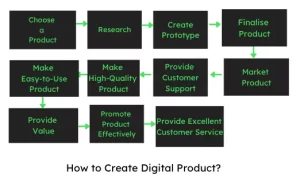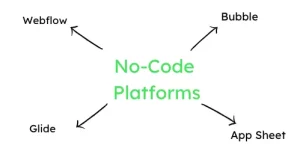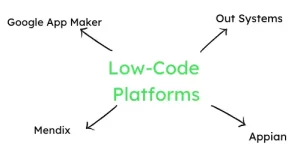How to Create Digital Products?
In our increasingly connected world, digital products streamline processes, enhance efficiency, and provide accessible solutions, driving the need for their integration into our daily lives. And that is why it is important to know about how you can create digital products.
Let us read in detail about digital products and how to create one.
What are digital products?
Digital products are intangible assets or pieces of media that can be sold online and distributed repeatedly. In this case, there is no need to replenish inventory.
MP3, PDF files, videos, plug-ins, and templates are some of the digital products that come in the form of downloadable or streamable digital files.
Here are some examples of digital products:
- Ebooks and Guide
- Downloadable Software
- Video Content
- Music and Audio
- Photography
- Digital Art and Graphics
- Online Courses
- Professional Services
Why Digital Products?
Digital products offer a number of advantages over physical products, including:
- Affordable Production: Creating digital products comes with low costs, making them ideal for small businesses and entrepreneurs.
- Effortless Distribution: Online distribution allows digital products to reach a global audience seamlessly.
- Scalability Advantage: Digital products scale easily, enabling increased sales without rising production expenses.
- Timeless Appeal: Digital products, with no expiration, offer the opportunity for continuous sales over the years.
How to Create a Digital Product?
Here are the steps on how to create a digital product:

- Select a product: Begin by choosing a digital product, such as an ebook, video course, or software.
- Conduct research: Ensure a market exists for your chosen product by examining similar offerings and surveying your target audience.
- Develop a prototype: Create an initial version for feedback, ensuring your product aligns with customer needs.
- Finalise your product: Make necessary refinements, format content, and design a cover.
- Market your product: Establish an online presence through a website, social media, or advertising.
- Provide customer support: Offer assistance, resolve issues, and facilitate refunds for a seamless customer experience once your product is launched.
Creating a digital product can be a great way to make money online. If you’re willing to work, you can create a successful digital product that will help you reach your business goals.
Ways Of Web App Development.
Let us discuss two ways of web app development:
The no code way of building product.
No-code represents a software development approach enabling users to craft applications without coding. Users assemble applications by piecing together pre-built code blocks using visual interfaces and drag-and-drop tools.
Benefits of No Code Website App Development
Several advantages accompany the use of no-code for product development:
- User-Friendly: No-code platforms prioritise simplicity, making application creation accessible to individuals without coding expertise.
- Swift Development: No-code expedites application building, bypassing the time-consuming complexities of manual coding.
- Cost-Efficiency: No-code proves a budget-friendly option, eliminating the need to hire developers for custom code creation.
- Scalability: Easily scale your applications with no-code platforms, effortlessly adding new features as your requirements expand.
- Technical skills not required: With no-code platforms, anyone can develop applications, eliminating the need for technical expertise. Bring your ideas to fruition without the necessity of learning coding.
- Enhanced productivity: Utilizing no-code platforms boosts productivity by automating repetitive tasks. This efficiency allows you to allocate more time to creative and strategic endeavors.
- Improved collaboration: No-code platforms make collaborating with others on projects easy. This is because they provide a visual interface that everyone can understand, regardless of their technical skills.
- Better communication: No-code platforms can help you improve your touch with your team. This is because they provide a real-time way to track progress and share feedback.
Some of the most popular no-code platforms include:

- Bubble: Bubble is a no-code platform that allows you to create web and mobile applications.
- Webflow: Webflow is a no-code platform that enables you to create websites and web applications.
- Glide: Glide is a no-code platform that allows you to make data-driven applications.
- AppSheet: AppSheet is a no-code platform that allows you to develop mobile applications.
No code is an excellent option if you’re looking for a way to build applications quickly, easily, and affordably. There are a number of benefits to using no-code, including ease of use, speed, cost-effectiveness, scalability, and increased productivity.
The low code way of building product.
Low code is an approach to software development that combines code and visual tools for faster and more efficient application creation than traditional coding methods.
Benefits of Low Code Website Development
Using low code for product development offers various advantages, such as:
- Enhanced productivity: Low-code platforms empower developers to boost productivity by automating repetitive tasks, allowing them to dedicate more time to creative and strategic endeavors.
- Improved collaboration: Low-code platforms make collaborating with others on projects easy. This is because they provide a visual interface that everyone can understand, regardless of their technical skills.
- Better communication: Low-code platforms can help improve communication within your team. This is because they provide a real-time way to track progress and share feedback.
- Reduced costs: Low-code platforms can be a cost-effective way to build applications. This is because you can hire fewer developers and use pre-built components to speed up development.
- Scalability: Low-code platforms can be scaled easily, as you can add new features and functionality as your needs grow.
- No coding skills required: With low-code platforms, anyone can develop applications, eliminating the need for coding expertise. This allows you to bring your ideas to life without learning to code.
- Increased versatility: Low-code platforms provide extensive flexibility, allowing you to choose the coding level that suits your preferences. This means you can employ low code to create applications of varying complexity.
- Enhanced security: Low-code platforms frequently incorporate built-in security features, safeguarding your applications from unauthorized access
Some of the most popular low-code platforms include:

- OutSystems: OutSystems is a low-code platform that allows you to create web and mobile applications.
- Appian: Appian is a low-code platform that allows you to create enterprise applications.
- Mendix: Mendix is a low-code platform that allows you to create custom applications.
- Google App Maker: Google App Maker is a low-code platform that allows you to create web applications.
Low code is an excellent option if you’re looking for a way to build applications more quickly and efficiently than traditional coding methods. There are a number of benefits to using low code, including increased productivity, improved collaboration, better communication, reduced costs, scalability, no need for coding skills, increased flexibility, and better security.
Also Read : How to Develop a Progressive Web App?
Things To Keep in Mind For Web App Development
Regarding iOS app development or Android app development, there are several important factors to keep in mind. Here are some key considerations:
| Considerations | iOS App Development | Android App Development |
| Design Guidelines | Follow Apple’s Human Interface Guidelines (HIG) for design | Follow Google’s Material Design guidelines for design |
| Screen Sizes | Adapt app layout for different iPhone and iPad screen sizes | Design for various Android device screen sizes and densities |
| Core Features | Utilise Apple-specific features and APIs (Touch ID, Apple Pay) | Utilise Android-specific features and APIs (Google Maps) |
| Testing | Test on real iOS devices to ensure compatibility and performance | Test on real Android devices to ensure compatibility |
| App Store Guidelines | Comply with App Store Review Guidelines for app submission | Comply with Google Play Store guidelines for app submission |
| Security and Privacy | Implement secure data transmission and handle user data securely | Implement secure communication and handle user data securely |
| Updates and Maintenance | Stay updated with the latest iOS versions and regularly update app | Stay updated with the latest Android versions and update app |
| Developer Program | Enrol in Apple Developer Program for resources and distribution | Utilise Google Play Console for app management and release |
Conclusion
Crafting a digital product demands a systematic approach to success. Prioritize user-centric design, platform compatibility, security, and updates for a seamless user experience. Stay responsive to feedback and market trends for continuous improvement. By embracing these principles and understanding your target audience, create a standout digital product that adds value in a competitive landscape.We can help you create any form of digital asset development. You can write to us at hello[at]noboruworld.com
FAQ’s
What are digital assets?
Digital assets encompass various digital media forms, including images, videos, audio files, documents, designs, software, and more, existing in electronic format.
Why are digital assets important?
In the digital age, these assets are crucial, facilitating content creation, broader audience reach, and improved communication. They’re essential for individuals, artists, and creators to showcase, preserve, and monetize their work.
How can digital assets be protected?
Safeguarding digital assets involves digital rights management, encryption, secure storage, and copyright mechanisms.
How can digital assets be monetized?
Monetization options include selling license subscriptions, running ads, affiliate marketing, and offering premium or exclusive content.
Also Read – The Most Profitable Products and the Best Platforms to Sell



